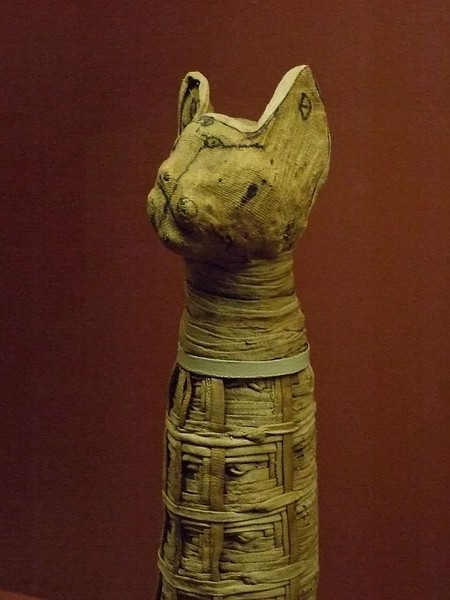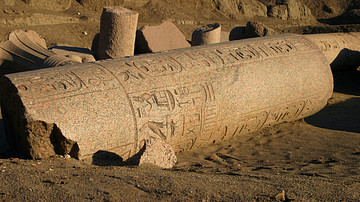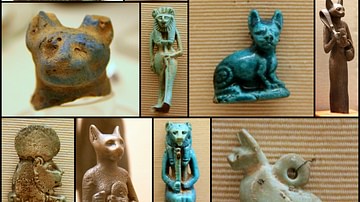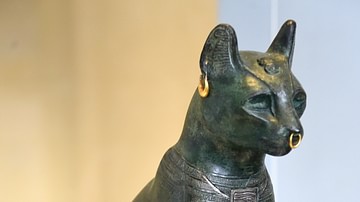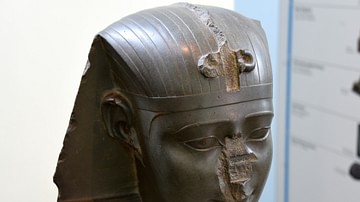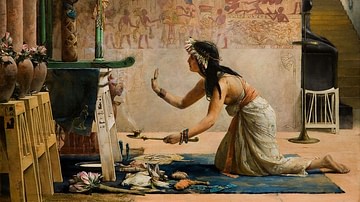The ancient Egyptians had a great reverence for life in all its forms. Life had been given by the gods and reverence for it extended beyond human beings to all living things. Although the Egyptians did occasionally eat meat, and their royalty certainly engaged in the hunt, the Egyptian diet was primarily vegetarian or pescatarian, and this reflected the understanding of the sacred nature of all existence. Even when animals were eaten, thanks were given for the sacrifice, pets were well cared for, and wildlife in nature was respected.
This value is visible everywhere throughout their culture from art to Egyptian religion but is epitomized by the Battle of Pelusium of 525 BCE. This engagement was the decisive clash between the Pharaoh Psametik III (526-525 BCE) and the Persian king Cambyses II (525-522 BCE), resulting in the first Persian conquest of Egypt.
It has been suggested that the battle would have gone to the Persians regardless of the tactics used since Cambyses II was far more experienced in war than the young Pharaoh Psametik III. The victory, however, was due far more to Cambyses II's knowledge of Egyptian culture than his record as a field commander. The battle was won through a very unusual strategy on Cambyses II's part: the use of animals as hostages and, especially, cats.
Bastet & Her Cats
Cats were a popular pet in ancient Egypt and closely associated with the goddess Bastet (also known as Bast) who appears in Egyptian art with the body of a woman and the head of a cat or as a sitting cat in a regal pose. She was the goddess of the home, domesticity, women's secrets, cats, fertility, and childbirth. She protected a household from evil spirits and disease, especially diseases affecting women and children, and also played a role in one's afterlife.
Bastet was extremely popular throughout Egypt with both men and women from the 2nd Dynasty (c. 2890 - c. 2670 BCE) onward, with her cult centered at the city of Bubastis from at least the 5th century BCE. She was first represented as a woman with the head of a lioness and closely associated with the vengeful goddess Sekhmet, but the two diverged over time until Bastet was imagined as more of a close companion while Sekhmet remained a force of divine vengeance. Even so, this did not mean Bastet could not dispense justice or right wrongs when she saw the need. Egyptologist Geraldine Pinch writes:
From the Pyramid Texts onward, Bastet has a double aspect of nurturing mother and terrifying avenger. It is the demonic aspect that mainly features in the Coffin Texts and the Book of the Dead and in medical spells. The "slaughterers of Bastet" were said to inflict plague and other disasters on humanity. (115)
Among the many ways people could offend the goddess was to harm one of her cats. Cats were so highly regarded in ancient Egypt that the punishment for killing one was death, and as Herodotus reports, Egyptians caught in a burning building would save the cats before saving themselves or attempting to put out the fire. Herodotus says, further, "All the inmates of a house where a cat has died a natural death shave their eyebrows" as a sign of their grief, and cats were mummified with jewelry just as people were (Nardo, 96). It has been suggested that cats were sacrificed to Bastet in the same way dogs were to Anubis, but this claim has been challenged. It is possible the mummified cats found at Bubastis were pets who had died naturally and were brought to be interred at a sacred spot. This precedent is set by graves of humans and animals buried at Abydos in order to be close to Osiris.
The respect the Egyptians had for animals extended beyond the cat and dog, however. Mummified pets of different kinds have been found including gazelles, baboons, birds, and even fish. Certain animals, like the cat and dog, did seem to have a special significance, however, due to their association with deities and it was this knowledge of Egyptian culture and values which gave Cambyses II the victory at Pelusium regardless of the youth of his opponent or Egypt's decline as a world power after the New Kingdom.
Egypt in the Third Intermediate Period
The period of the New Kingdom of Egypt (c. 1570 - c. 1069 BCE) was a time of prosperity and growth in every area of the civilization. This was the age of the Egyptian Empire during which its borders expanded and treasury filled. The best-known rulers in Egyptian history come from this era: Ahmose I, Hatshepsut, Thutmose III, Amenhotep III, Akhenaten, Nefertiti, Tutankhamun, Horemheb, Seti I, Ramesses the Great, Nefertari, and Ramesses III are all New Kingdom nobility. The opulence and success of this era could not last, however, and by c. 1069 BCE the empire was falling apart and the country entered what later scholars have called the Third Intermediate Period of Egypt (c. 1069 - 525 BCE).
This time is characterized by a lack of a strong central government, civil war, and social instability although it was not as dark or dismal as early Egyptologists would claim. Even so, the country was nowhere near the strength or military might of the New Kingdom. In the latter part of the 22nd Dynasty, Egypt was divided by civil war and, by the time of the 23rd, the country was divided between self-styled monarchs who ruled from Herakleopolis, Tanis, Hermopolis, Thebes, Memphis, and Sais. This division made a united defense of the country impossible and allowed for the Nubian invasion from the south.

The 24th and 25th dynasties were then unified under Nubian rule, which was quite successful, but the country was not strong enough to resist the advance of the Assyrians first under Esarhaddon (681-669 BCE) in 671/670 BCE and then by Ashurbanipal (668-627 BCE) in 666 BCE. Although the Assyrians were driven from the country, Egypt would not have the resources to withstand the coming of the Persians.
Cambyses II & Amasis
Pharaoh Amasis of the 26th Dynasty (also known as Ahmose II, 570-526 BCE) was among the greatest rulers of this period and restored some of Egypt's former glory and military prestige. He would be among the last of the effective kings in Egypt's history, however, and, if Herodotus is to be trusted on this, initiated the problem which led to the Persian invasion.
According to Herodotus, Cambyses II invaded Egypt after being insulted by Amasis. Cambyses II had written to Amasis asking for one of his daughters as a wife, but Amasis, not wishing to comply, sent the daughter of his predecessor Apries. The young woman was insulted by this decision - especially since it was a tradition that Egyptian women were not given to foreign kings - and when she arrived at Cambyses II's court, she revealed her true identity. Cambyses II accused Amasis of sending him a 'fake wife' and mobilized his troops for war.
Whether this story is true, the Persians would have eventually attacked Egypt anyway. The Assyrians had already conquered the country in the late 7th century BCE, and the Egyptian army had proven itself no match for the superior weapons and tactics of the Mesopotamian forces. The Persians, who were expanding their empire, would have known of the earlier conquest and Egypt's inability to defend itself as it could in the New Kingdom and so would have had little hesitation in launching an invasion.
Preparation for the Battle
Assuming Herodotus is correct, in between the insult and the battle, Amasis died and left the country in the hands of his son Psametik III (also known as Psammeticus III). Psametik III was a young man who had lived largely in the shadow his father's great accomplishments and was hardly equipped to fend off a hostile force. When word of the Persian mobilization reached him, however, he did his best to mount a defense and prepare for battle. He was counting on the assistance of Greek allies, who deserted him, and he was without the military counsel of Phanes of Halicarnassus (his father's advisor), who had already gone over to the Persian side. Psametik III was therefore left on his own to handle the crisis.
Psametik III fortified his position at Pelusium near the mouth of the Nile and awaited the Persian attack while simultaneously preparing his capital city of Memphis to withstand a siege. The fortress of Pelusium was strong and well provisioned and so was the capital. The young pharaoh, who had only ruled for six months at the time, must have felt confident he could repel any attack. What Psametik III did not count on, however, was Cambyses II's cunning.
The Battle & Aftermath
The 2nd-century CE writer Polyaenus describes Cambyses II's approach in his Strategems, which he wrote in the hopes of helping Marcus Aurelius and Verus in their campaigns. Polyaenus recounts how the Egyptians were successfully holding back the Persian advance when Cambyses II suddenly switched tactics. The Persian king, knowing the veneration the Egyptians held for cats, had the image of Bastet painted on his soldiers' shields and, further, "ranged before his front line dogs, sheep, cats, ibises and whatever other animals the Egyptians hold dear" (Polyaenus VII.9). The Egyptians under Psametik III, seeing their own beloved goddess on the shields of enemies, and fearing to fight lest they injure the animals being driven before the enemy, surrendered their position and took flight in a rout.
Many were massacred on the field, and Herodotus reports seeing their bones still in the sand many years later; he even commented on the difference between the Persian and the Egyptian skulls. Those Egyptians not killed at Pelusium fled to the safety of Memphis with the Persian army in pursuit. Memphis was besieged and fell after a relatively short interval. Psametik III was taken prisoner and was treated fairly well by Cambyses II until he tried to raise a revolt and was executed.
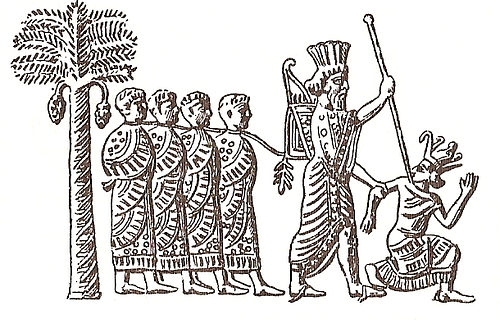
It should be noted, however, that Herodotus' depiction of Cambyses II has been challenged. Cambyses II is often depicted as a brutal and careless monarch by the Greek writers who had no love for the Persians. Cambyses II is also said to have killed the sacred Apis bull and thrown its carcass into the street and also to have defiled and banned sacred rites and traditions throughout Egypt.
This claim is contradicted by reports of other writers, inscriptions, and artwork which shows Cambyses II's great appreciation for Egyptian culture and religion including his rebuilding of Memphis and its continuation as the capital of the Persian satrapy. The very fact that he used their values against them in battle attests to this admiration; he knew the Egyptians would respond exactly as they did because they could not do otherwise. They would have thought it better to surrender than betray their beliefs.
After the Battle of Pelusium, the Persians would rule Egypt in the 27th and 31st Dynasties and pose a constant threat, even when they were driven out, in the 28th - 30th. Except for brief periods, Egypt ceased to be an autonomous nation following the Persian victory. Alexander the Great arrived with his armies in 331 BCE and conquered the land, and it was then ruled by a Greek monarchy until annexed by Rome in 30 BCE.
Polyaenus observes how, through this trickery, Cambyses II opened up the route into Egypt and the path to victory. He further observes that one must never trust in one's own strength or goodness in battle but instead prepare for any contingency. While this may be sound advice, the refusal of the Egyptians to compromise their beliefs - no matter the cost - is a telling detail in understanding what made their culture so admirable and their civilization among the most impressive.

